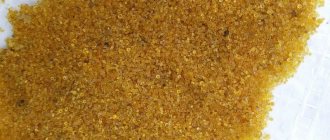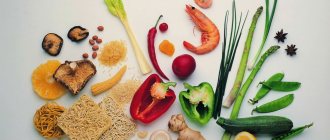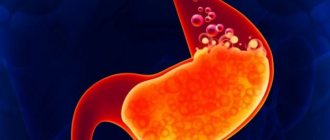The danger of acidity deviation from normal
If the gastrointestinal tract does not function properly, food is poorly digested and the body does not receive enough nutrients. Insufficient acid levels stimulate fermentation processes in the stomach and intestines and can cause anacid gastritis, gastroduodenitis, and malignant neoplasms.
Excess provokes ulcers and problems with the pancreas. People whose pH levels are higher or lower than normal need to know which foods will increase their acidity. This will allow you to correctly adjust the diet and normalize the amount of alkali. Signs of low stomach acidity are nausea, flatulence, frequent belching of air, a feeling of heaviness after eating.
General characteristics of products that increase acidity
Products that increase stomach acidity differ from others in their significant content of certain microelements. These are magnesium, potassium, calcium, and sodium. The table shows where the most specific micronutrients are found.
| Potassium | Calcium | Sodium | Magnesium |
| tangerines | soybeans | sturgeon | sesame |
| bananas | lentils | sardine | flax seeds |
| oranges | beans | flounder | sunflower seeds |
| lemon | peas | shrimps | pumpkin seeds |
| radish | cheese | crayfish | Pine nuts |
| tomatoes | cottage cheese | mussels | walnuts |
| carrot | cereals | octopus | cocoa |
| dried apricots | vegetables | oysters | chocolate |
| raisin | fruits | tomatoes | peas |
| figs | berries | cucumbers | lentils |
| prunes | parsley | beet | beans |
| nuts | green onions | carrot | sea kale |
| fish | dill | beans | mushrooms |
| liver | cereals | lentils | millet cereal |
| cereals | almond | beans | apricots |
| cottage cheese | poppy | peas | |
| zucchini | sesame | cereals | |
| grapefruits | cilantro |
All of these products are important for the human body. However, people with high acidity should keep their consumption to a minimum. Those whose pH is insufficient need to ensure that there is more potassium, calcium, sodium, and magnesium in the menu.
Diet menu for high stomach acidity
Below is an approximate menu for 3 days, which you can create yourself based on the list of permitted products.
| Diet menu for 3 days | ||
| Day | Eating | Products and dishes |
| 1 day | Breakfast | Steam omelette, 1 glass of milk with a fat content of no more than 3% |
| Lunch | Oatmeal cooked with low-fat milk. | |
| Dinner | Soup with pasta and beef, green buckwheat porridge, dried fruit compote. | |
| Afternoon snack | Banana pudding, tea (preferably green). | |
| Dinner | Millet porridge, chicken (boiled), low-fat milk. | |
| Day 2 | Breakfast | 2 bananas, tea or dried fruit compote |
| Lunch | Crackers (preferably made from wheat bread), green tea | |
| Dinner | Vegetable stew with pieces of chicken breast, bread, green tea. | |
| Afternoon snack | Casserole with raisins, juice or compote of non-acidic fruits | |
| Dinner | Rice porridge, sea fish fillet, mineral (still) water. | |
| Day 3 | Breakfast | Buckwheat porridge with water, boiled chicken fillet, tea (preferably green). |
| Lunch | Banana, low-fat yogurt. | |
| Dinner | Vegetable and beef stew, jelly. | |
| Afternoon snack | Cottage cheese casserole, mineral (still) water. | |
| Dinner | Chicken cutlets (steamed), mashed potatoes, apple jelly. | |
Alcoholic drinks
Alcohol is one of the main enemies of a normal acid-base environment. Even small doses cause a serious release of a substance that corrodes the walls of the stomach. Doctors say that the following drinks are more harmful than others:
- wine;
- alcohol tinctures;
- champagne;
- unfiltered beer.
Regular consumption of alcohol inevitably leads to problems with the gastrointestinal tract, which are not easy to solve. For people already suffering from gastritis, ulcers, or pancreatitis, alcohol is strictly contraindicated. Healthy people should reduce their alcohol consumption to a minimum, or better yet, abstain from it altogether.
We advise you to read: How to determine stomach acidity at home
Fruits and vegetables that stimulate acid production
Gastroenterologists often recommend excluding fruits from the menu. They are among the leaders in their ability to increase acidity. However, the effects on the body of different fruits are different. The most dangerous for people with high acidity are:
- pomegranate is rich in vitamin C, which negatively affects the mucous membrane;
- melon is difficult to digest, activating the secretion of large quantities of gastric juice;
- grapes are difficult to process in the gastrointestinal tract and cause fermentation processes;
- peaches increase the activity of secretory glands;
- kiwis consist of small fibers that can damage the mucous membrane;
- Citrus fruits contain a lot of acid.
Vegetables that increase pH include:
- cabbage;
- tomatoes;
- zucchini;
- cucumbers
The last of these pickled vegetables are especially dangerous for people with high acidity. Cabbage is not recommended in any form. In other cases, heat treatment slightly reduces the ability of vegetables and fruits to increase acidity.
Principles of nutrition
When preparing a diet for a person with increased gastric secretion, doctors advise following several principles of proper nutrition:
- meals are small and frequent (5-6 times a day). Food portions should be small in order to reduce stress on the stomach;
- drink at least two liters a day of clean water to dilute gastric juice;
- the diet should consist of healthy foods recommended by a doctor or nutritionist;
- exclude prohibited foods and drinks from the diet;
- products are consumed boiled, stewed or steamed;
- food should be soft, without hard lumps;
- food should be consumed warm, at a temperature close to the temperature of the human body;
- breakfast should be hearty;
- in the evening you need to eat a few hours before bedtime;
- do not take strong medications (for example, NSAIDs - ibuprofen, diclofenac, etc.) that irritate the gastric mucosa;
- avoid nervous tension and stress.
Diets
A gastroenterologist or nutritionist can recommend how to eat and what foods are allowed to be eaten in case of high acidity of the stomach and patients with gastritis.
Depending on the degree of manifestation of pain and dyspeptic symptoms, the following therapeutic diets are prescribed to reduce acidity levels:
- No. 1A – used in the acute period of exacerbation. All effects on the stomach are limited as much as possible. Only boiled and liquid dishes are consumed (slimy porridges and soups, pureed meats, compotes, jelly). Fresh vegetables and fruits are prohibited;
- No. 1B – prescribed when the condition improves. Dishes are prepared in the same way, but may be thicker. Coarse vegetable puree, soufflé from lean varieties of fish and meat are allowed;
- No. 1 is the main treatment table, which contains a balanced amount of fats (except animals), proteins and carbohydrates and moderate stomach sparing.
The goal of a diet for high stomach acidity is to:
- eliminate dyspeptic symptoms (nausea, heartburn, belching, flatulence);
- relieve pain;
- improve food digestion;
- reduce gastric excitability;
- reduce the acid factor.
Prohibited Products
What should you not eat if you have hypersecretion of gastric juice? During a therapeutic diet, foods that stimulate the production of gastric juice are always excluded, thereby causing an increase in acidity levels:
- broth (meat, fish, mushroom),
- fatty or tough meat (pork, beef, goose, duck);
- fatty fish;
- bakery products and various baked goods;
- sour drinks;
- rough vegetables and cereals;
- fermented milk and high-fat dairy products (cream, sour cream, kefir);
- smoked meats, sausages;
- marinades, semi-finished products, canned food;
- fried and spicy foods;
- tea, coffee, alcohol;
- sour fruits and berries (citrus fruits, cranberries);
- turnips, tomatoes, radishes, garlic, onions, cabbage;
- irritating mucous membranes – spices, pepper, chocolate, ginger;
- causing flatulence and reflux - carbonated drinks, kvass, sweets, legumes.
People with high concentrations of acid in the stomach after 50 years should be especially careful about their health. With improper nutrition, a patient in this age category may experience atrophy of the gastric mucosa, which can degenerate into oncology.
Recommended Products
If you have high acidity, it is recommended to eat healthy foods that lower the level of acid in the gastric juice.
List of these products:
- lean meat (veal, chicken, rabbit);
- boiled lean fish;
- pureed vegetables without coarse fiber (carrots, potatoes, spinach, beets, pumpkin, cauliflower, zucchini);
- soft-boiled eggs or steamed omelet;
- well-cooked or pureed porridge (semolina, buckwheat, oatmeal, rice);
- a variety of cereals and pasta;
- vegetable oil;
- sweet berries and fruits with coarse fiber (blueberries, bananas, cherries, strawberries, pears, apples). In the acute period, fresh fruits are excluded from the diet, then consumed pureed (jelly, puree, jelly, compote);
- milk and dairy products (low-fat cottage cheese, natural yogurt, fermented baked milk, yogurt);
- honey, fruit sweets (mashed or baked), jelly and soufflé;
- dried bread or crackers.
The menu for a therapeutic diet should be varied and balanced, the recipes for dishes should be simple and made from healthy products. It is convenient to create an approximate menu for the week using a table. You can prepare pureed soup with pureed vegetables or cereals based on low-fat broths as first courses.
It is better to cook meat in minced form (meatballs, meatballs, cutlets). Porridges, which have an enveloping effect on the gastric mucosa, are well suited for a therapeutic diet. Fruit and vegetable juices, jelly, dried fruit compote, rosehip infusion, and still mineral water are very useful. You can drink weak coffee or tea with milk.
Fasting day
A fasting day can be carried out with an increased level of acidity in gastric juice no more often than after 10 days, but not during an exacerbation. It is good to use oatmeal on a fasting day. Rolled oatmeal for preparing oatmeal should be regular, not instant.
Recipe for making oatmeal: when the acidity level is high, oatmeal is boiled in water. Take 1 glass of rolled oats and 2.5 glasses of water. Place the cereal in boiling water and cook until tender (no more than 5-7 minutes). Add butter, salt and sugar to taste to the porridge. You can also add nuts, berries or pieces of fresh fruit (bananas, peaches).
It is very useful to cook oatmeal with a decoction of rose hips, rich in vitamin C. In addition, decoctions and infusions of rose hips have a beneficial effect on the mucous layer of the stomach walls. In addition to unloading on rolled oats, you can use other cereals (for example, buckwheat) on fasting days. The main thing is not to forget that the products should not be contraindicated, and the prepared dishes should not be complicated.
During the fasting day, you need to drink the required amount of liquid - up to 2 liters. You can drink pure or still mineral water, green tea, and herbal infusions. You should drink it half an hour before oatmeal or half an hour after eating.
Video on the topic
Folk remedies
In addition, you can use some traditional medicine recipes that reduce acidity and reduce the overall load on the stomach and intestines. Many medicinal herbs are used to treat various stomach diseases, including the treatment of gastritis. Before using any of the traditional medicine recipes as an additional treatment, you should consult your doctor.
Some traditional medicine recipes that reduce high levels of acid in gastric juice:
- mint – tea with mint actively reduces high acidity and has a calming effect;
- basil – the leaves of this plant have a beneficial effect on the microflora of the stomach, reduce pain and heartburn;
- yarrow and wormwood - an infusion of these herbs, taken in equal parts, helps eliminate heartburn and nausea;
- potato juice – taken raw daily on an empty stomach, you can significantly reduce the acidity level;
- chamomile - a decoction of flowers, drunk before meals, prepares the mucous layer of the stomach for work;
- honey and aloe – crushed aloe leaves, mixed in equal proportions with honey, eliminate inflammatory processes in the stomach;
- carrots (raw) – fresh carrot juice prevents excessive acid production;
- pumpkin and sea buckthorn oil - a mixture of these oils, taken in the morning, has a calming effect on the gastrointestinal tract;
- blueberries – berries can be used to make medicinal tea. The substance secretin contained in it helps the stomach digest food;
- pure water - a glass of cool water, drunk in the morning on an empty stomach, dilutes the increased concentration of hydrochloric acid in the gastric juice and relieves pain.
List of references: https://www.kp.ru/guide/kislotnost-zheludka.html https://www.cosmo.ru/health/diets/dieta-pri-povyshennoy-kislotnosti-menyu-i-pravila-pitaniya/ https://www.passion.ru/diet/effektivnye-diety/dieta-pri-gastrite-s-povyshennoy-kislotnostyu-86518.htm https://www.kp.ru/guide/pitanie-pri-gastrite.html https://www.wday.ru/krasota-zdorovie/sok/rekomendatsii-i-sovetyi-po-pitaniyu-pri-povyishennoy-kislotnosti-jeludka/ Nutrition for gastric diseases, Ilya Melnikov 2009 https://e- dostavka.by/articles/healthy/713.html med.vesti.ru/articles/zabolevaniya/dieta-pri-gastrite-zheludka/ https://elementaree.ru/blog/science/produkty-pri-gastrite-zheludka https: //www.justlady.ru/articles-125320-dieta-pri-povyshennoy-kislotnosti-zheludka https://onclinic.ua/blog/nuzhna-ly-dyeta-pry-gastryte https://telegraf.com.ua/ zhizn/zdorove/3884023-lechebnaya-dieta-pri-gastrite-s-povyishennoy-kislotnostyu.html Notes from the author of the article, based on personal experience. This material is purely subjective and is not a guide to action. Only a qualified specialist can determine an accurate diagnosis and prescribe treatment.
Last modified: 07/06/2020
Fatty and sweet
Foods with a high fat content are very difficult to digest. As a result, the acidity of gastric juice increases. Patients with gastritis, ulcers, and pancreatitis are recommended to include only lean varieties of meat and fish in the menu. You need to limit your consumption:
- oils;
- fat milk;
- cream;
- sour cream;
- margarine.
The listed products upset the gastric balance. Various sweets contribute to an increase in the amount of acid, most of which also contain an abundance of fats and are rich in carbohydrates. The leaders include baked goods and chocolate.
The white variety does not contain caffeine or cocoa powder. However, it contains a lot of vegetable fats, which give the product a pronounced sweetness. Brown chocolate is loaded with fatty milk powder and caffeine. Black is rich in cocoa (in the form of butter and powder). There is also a lot of caffeine in this chocolate. Products that do not affect the pH level - marshmallows, honey, halva.
Acidic and alkaline foods: list
Over the past decades, humanity has significantly changed its diet. This had a significant impact on my health.
Acidic and alkaline foods are consumed unbalanced, and this leads to many problems and various diseases: immunity decreases, stones form in the kidneys, and the risk of malignant tumors increases. Alkaline foods will help eliminate ailments and restore natural balance.
The right combination of ingredients in the diet makes it possible to avoid the risks of disease. So what role does the acid-base balance play in our body, and how to determine the food group?
Acid-base balance of the body, products
Each substance has its own pH value, which indicates how electrical resistance changes between negative and positive ions. One group produces an alkaline environment, the other an acidic environment.
For this indicator, scientists adopted a conditional number. A neutral environment has a pH level of 7.
If a shift occurs in a smaller direction, then we are talking about oxidation; a change in a larger direction means alkalization.
In the human body, the optimal level of alkali is considered to be 7.4. The limit of the lowest indicator is 7.36. If we are talking about an increase, then the limit figure is 7.44.
In any other cases, we will already be talking about pathological changes.
In many ways, these numbers depend on what acidic and alkaline foods you consume, because when they break down into molecules, they change the internal environment of the body.
In most cases, acids are synthesized during metabolism (lactic, uric acid), and when lymph, blood, and bile enter into a chemical reaction with alkali, neutralization occurs.
However, if acidic foods predominate in the diet, our body is not able to cope with all the incoming acids.
In such cases, unpleasant symptoms arise: headache, fatigue, anorexia, loss of appetite, hyperacidity, nervous tension, insomnia.
Causes of osteoporosis
Due to increased blood acidity, other undesirable effects may occur. Sodium is used by the body as a buffer to maintain homeostasis and return the acidic pH factor to normal levels. As a result, its reserves may be depleted.
If sodium is unable to buffer the accumulated acid, the body uses its own calcium as a second buffer. It begins to leach from teeth and bones if insufficient quantities are supplied with food. At the same time, the bones become weak, brittle, and porous.
In medicine, this condition is called osteoporosis.
If acidic and alkaline foods are consumed unbalanced, an increase in acidity occurs, this is an abnormal condition. The processes of aging and degeneration of the body are accelerating. Toxic substances in the human body are contained in the form of acids. To maintain and strengthen your health, you need to consume more foods that are alkaline in nature.
When acidification occurs in the body, almost all ailments seem to be waiting for this and begin to overcome our body. Poor nutrition, which we have been practicing for years, confidently begins to suck vital energy from every cell. Acidic and alkaline foods should be consumed in balance. If the acid predominates and neutralizes the alkali, the following consequences may occur:
- The human skeleton suffers.
- The body uses all reserves to produce alkalization. This releases calcium and magnesium. Minerals are washed out of the bone, causing osteoporosis.
- The brain, receiving a signal about a lack of calcium, increases its amount in the blood. But, as a rule, it does not return to the bones, but accumulates on surfaces, in the gallbladder, in the kidneys. Hence diseases such as polycystic disease, cysts, and benign tumors in the breast.
- Clouding of the lens occurs and cataracts develop.
- Progression of cardiovascular diseases.
- The composition of the blood changes, and the risk of cancer arises.
- Constant acidosis, therefore, hypothyroidism, insomnia, anxiety, edema, low blood pressure.
- Acidification provokes chronic fatigue and muscle pain even at a young age.
- Tooth enamel is destroyed.
- Metabolism slows down, aging processes accelerate.
- Internal organs fail, enzymes reduce their efficiency.
If you normalize your alkaline balance, pathologies will begin to decrease. It won’t be possible to completely eliminate acidic foods from your diet, but you need to monitor their quantity and be sure to consume alkaline foods.
Theory of cancer
The acid-base balance of foods is very important for our body. Researchers have already proven that acidic foods in excessive quantities aggravate the risks of the occurrence and progression of cancer.
Back in 1932, Otto Warburg established the obvious dependence of the development of cancer on acidification of the body. Cancer cells are viable only in an acidic environment, where the pH is below 7.
If alkalization occurs, the pH level rises, then within 3 hours the pathogenic elements begin to die.
Some scientists, despite the protests of traditional medicine, put forward theories that cancer can be cured by alkalization. Products that have an alkaline reaction can reduce the likelihood of tumor recurrence and even reduce the likelihood of cancer cells.
Leaders in maintaining alkaline balance. TOP 7
Below is a list of products that are considered leaders in the alkaline balance. Many people are interested in: is lemon an alkaline or acidic product?
- Lemon. Despite its sour taste, it is the leader among all those that give an alkaline reaction. Some supporters of alternative methods of treatment believe that this citrus is 10 thousand times stronger than chemotherapy. According to Ayurveda, drinking the fresh juice of this product or eating one lemon a day can get rid of any disease. In this case, you cannot add sugar!
- Greenery. Parsley, dill, lettuce, leeks will not only saturate the body with a variety of vitamins, minerals and antioxidants, but will also restore the alkaline balance.
- Roots. Turnips, radishes, horseradish, carrots, rutabaga, and beets can improve digestion and neutralize high acidity.
- Cucumbers and celery. The most alkaline foods.
- Garlic. It has antifungal and antibacterial properties, helps support the immune system, and restore alkaline balance.
- Cruciferous vegetables include cabbage, Brussels sprouts, cauliflower, and broccoli.
- Avocado is a source of amino acids and vitamins. Leader in fatty acid content of plant origin.
Don't want to know what serious illnesses are? Eat at least one of the listed foods fresh daily, and your alkaline balance will be normal.
Yoga
The acid-base balance of foods has been maintained in yoga for many years since ancient times. They include all animal products, many grains, legumes, cheese, and cottage cheese as acidic foods. Yoga considers alkaline foods to include fruits, vegetables, many nuts, herbs, yogurt, curdled milk and milk.
In Europe, more than a hundred years ago, the German scientist Berg first drew attention to this. They proved that the alkaline balance in the body is achieved by the correct selection of foods.
As yogis recommend, per day one part of acidic foods should be at least two parts of alkaline foods. Healthy people have an alkaline internal environment; it ensures proper functioning, gives longevity and strength, and reduces the need for proteins.
Prolonged acidification leads to premature senility and brings disease.
Alkaline diet
Which foods are alkaline and which are acidic, see the lists below. Consider the concept of an alkaline diet, which is used to normalize weight. If a person consumes acidic foods in excess, then the body tends to “acidify.”
In this case, a variety of diseases arise, often leading to osteoporosis and cancer. Promotes acidification and obesity.
What is the connection between excess weight and acidification? The fact is that excess acid is stored in fat deposits; in this case, they cannot decrease; the body protects its “reserves” of acid.
To successfully fight the acidification of fat deposits, you should think about an alkaline diet, the right foods will help. We present a list of alkaline and acidic foods, after studying which you can balance your diet. By following an alkaline diet, you can quickly lose weight and restore your health.
Considering the list of alkaline and acidic foods, let's first pay attention to the first. They are high alkaline, medium alkaline, low alkaline and very low alkaline.
High alkaline foods:
- Lemons.
- Baking soda.
- Chlorella.
- Red algae.
- Lime.
- Lentils.
- Alkaline mineral water.
- Onion.
- Nectarine.
- Persimmon.
- Pumpkin seeds.
- A pineapple.
- Sea kale.
- Sea salt.
- Sweet potato.
- Spirulina.
- Vegetable juices.
- Mandarin
- Watermelon.
Medium alkaline products:
- Apricots.
- Apples.
- Arugula.
- Broccoli.
- Asparagus.
- Carrot.
- Cantaloupe.
- Cashew nuts.
- Orange.
- Chestnut.
- Garlic.
- Chicory.
- Fresh ginger.
- Ginseng tea.
- Grapefruit.
- Greenery.
- Honeydew honey
- Kiwi.
- Tea mushroom.
- Kohlrabi.
- Syrup.
- Mango.
- Mustard greens.
- Parsnip.
- Olives.
- Raspberries.
- Turnips.
- Soy sauce.
- Black pepper.
Low alkaline foods:
- Almond.
- Apple vinegar.
- Sour apples.
- Avocado.
- Artichokes.
- Blackberry.
- Bell pepper.
- Cauliflower, white cabbage.
- Chicken eggs.
- Quail eggs.
- Ginseng.
- Eggplant.
- Honey.
- Mushrooms.
- Tremble.
- Peach.
- Papaya.
- Pumpkin.
- Potato.
- Homemade marinades.
- Swede.
- Sake.
- Rice syrup.
- Sesame seeds.
Very low alkaline foods:
- Bananas.
- Beet.
- Avocado oil.
- Brussels sprouts.
- Blueberry.
- Celery.
- Cucumber.
- Coconut oil.
- Cilantro.
- Sauerkraut.
- Currant.
- Melted butter.
- Linseed oil.
- Grape.
- Oats.
- Olive oil.
- Raisin.
- Strawberry.
- Zucchini.
- Sunflower seeds.
- Wild rice.
- Turnip.
It is worth noting that black tea, instant coffee, and alcohol belong to the group of acidic products, but for those who are interested in whether coffee is an alkaline or acidic product, we make an important note - natural coffee belongs to alkaline products.
High acid foods
Acidic foods create an acidic environment in the body, no matter how they taste. Now, considering the list of alkaline and acidic products, let us highlight the second group more specifically.
- Bread.
- Beef.
- Beer.
- Cocoa.
- Brown sugar.
- Wheat flour.
- Cottonseed oil.
- Fruit juices.
- Hop.
- Fried foods.
- Hazelnut.
- Ice cream.
- Jams and jellies.
- Industrial marinades.
- Seafood.
- Sugar.
- Salt.
- Wine.
- Vinegar.
- Walnuts.
- Yogurt is sweet.
Medium acid products
- Barley.
- Chestnut oil.
- Bear meat.
- Casein.
- Chicken.
- Cottage cheese.
- Corn.
- Cranberry.
- Fructose.
- Egg white.
- Chickpeas
- Pasteurized honey.
- Green pea.
- Mustard.
- Ketchup.
- Muesli.
- Palm oil.
- Pasta.
- Bakery.
- Pistachios.
- Peanut.
- Pomegranate.
- Pork.
- Popcorn.
- Rye.
- Veal.
- Soy milk.
Low acid foods
- Beans.
- Vodka.
- Almond oil.
- Buckwheat.
- Black tea.
- Cow's milk.
- Goat milk.
- Goose.
- Game.
- Mutton.
- Plum.
- Milk.
- Cancers.
- Tomatoes.
- Turkey.
- Wheat.
- Vanilla.
- White rice.
Very low acid products:
- Amaranth.
- Brown rice
- Rapeseed oil.
- Butter.
- Cream.
- Curry.
- Coconut.
- Fish.
- Figs
- Gelatin.
- Offal.
- Millet.
- Sunflower oil.
- Rhubarb.
- Zucchini.
- Wild duck.
Source: https://FB.ru/article/308575/kislotnyie-i-schelochnyie-produktyi-spisok
The effect of spices on acidity
Few people will like bland food. However, many spices provoke high acidity. Among them:
- ground black pepper;
- Chile;
- nutmeg;
- carnation.
They should not be included in the menu for people with high levels of acid in the gastric juice.
Interesting! Scientists have proven that these spices do not affect pH if a person consumes them from early childhood. Seasonings have a negative effect only on those people whose stomachs are not accustomed to them.
How to normalize acidity
If acidity is higher than normal, it should be reduced not only with medications, but also with complete or partial rejection of the above products. Fractional nutrition, when a person eats often, but in small portions, helps lower the pH level. Food should be prepared only by steaming, baking or boiling. Fried foods are excluded from the diet.
Nutrition for low stomach acidity is very important in restoring balance. Diet helps lower or increase pH and is an integral part of treatment. Avoid eating too much food that increases acidity. Forbidden drinks include alcohol, coffee, and soda. They reduce the availability of:
A diet for low stomach acidity must include:
However, vegetables and fruits should be consumed in small quantities, as they lower pH. It is allowed to flavor food with spices only within reasonable limits. In the morning you can drink a cup of coffee, on a hot summer day - a little kvass. You should not focus on:
- rice;
- oatmeal;
- corn and pearl barley;
- potatoes;
- apples;
- iris;
- baking from rye flour.
However, there is no need to completely abandon them. It is recommended to eat at low and high acidity often, but little by little. It is highly undesirable to wash down your meal with cold water.
You will also be interested in the video: How to reduce the acidity of gastric juice
If problems with the imbalance of acidity in the stomach have just begun, first lower or increase acidity only with the help of foods. A proper diet will normalize the situation, negative symptoms will go away and treatment will not be required. Eating unhealthy food will only make the situation worse and lead to serious illness.
It is important for people suffering from diseases of the digestive tract to regulate their diet. There are foods that increase stomach acidity. Their consumption will contribute to the exacerbation of diseases of the digestive tract.
Hot and cold drinks
Apart from alcohol, sweet soda ranks first among drinks in terms of its ability to increase acidity. It irritates the gastric mucosa, activating secretion. Kvass has an almost identical effect.
Coffee, on the contrary, helps relax the muscles, which become unable to hold acid in the stomach, and it is thrown into the esophagus. The person experiences heartburn. An increase in pH is provoked by the consumption of tomato, lemon, orange and tangerine juice.











